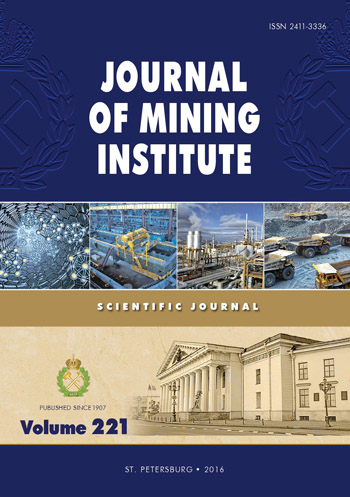Development of import subtituting technologies for increasing productivity of sintering machines and strength of agglomerates
- 1 — Ph.D., Dr.Sci. professor Saint-Petersburg Mining University
- 2 — Ph.D., Dr.Sci. professor Saint-Petersburg Mining University
Abstract
A problem of industrial fluxed agglomerates self-destruction in the process of cooling after sintering has been examined. It has been revealed that the main reason of strength degradation is polymorphism of dicalcium silicate Ca2SiO4 (or short designation С2S): β-Ca2SiO4 ® γ-Ca2SiO4. Ways for increasing the agglomerate strength by physical and crystal-chemical stabilization of the high temperature modification of C2S have been proposed and tested. Physical stabilization of C2S agglomerate is increased with its structure reinforcement due to thickening of walls between large pores that is achieved by increasing height of the sintered layer through improvement of its gas permeability. The task is addressed by substituting the previously used import sintering ore with the polydisperse ore from the Yakovlevo field, which improves the charge pelletizing by 3-4 times and helps to bring the height of the sintered layer and the strength of the domestic agglomerate up to the international best practice standards, while eliminating a need to purchase import high-vacuum exhausters. In practice crystal-chemical stabilization of C2S within iron-ore agglomerate is ensured by adding an opti- mal multicomponent additive in the form of the waste product generated in production of alumina from bauxites, i.e. the red mud, to the initial sinter charge. Thus mechanical strength of agglomerates and pellets is increased by 5-10 % and their hot strength improves by 20-40 %. The productivity of sintering machines and blast furnaces improves by 5-10 %. Specific coke consumption reduces by 2-2.5 %. In production of iron-ore pellets red mud is substituting the import bentonite.
References
- Bersenev I.S., Bokovikov B.A., Klein V.I., Kutuzov A.A., Yaroshenko Yu.G. Gas-Dynamic Properties of Initial Sinter Charge Layer. Stal'. 2010. N 9, p.16-18 [in Russian].
- Gerasimov L.K., Zhuravleva L.G., Frolov Yu.A., Dobryakov G.G. Gas-Dynamic Properties of Agglomeration Charges. Izvestiya vuzov. Chernaya metallurgiya. 1984. N 2, p.31-32 [in Russian].
- Korotich V.I., Frolov Yu.A., Bezdenezhnyi G.N. Agglomeration of Ore Materials. UGTU-UPI. Ekaterinburg. 2003, p.400 [in Russian].
- Vegman E.F., Zherebin N.F., Pokhvisnev A.N., Yusfin Yu.S., Kurunov I.F., Paren'kov A.E., Chernousov P.I. Cast Iron Metallurgy. Moscow: Akademkniga. 2004, p.774 [in Russian].
- Panychev A.A. Agglomeration Process Mathematical Model for Its Optimization and Automation. Obogashchenie rud. 2006. N 2, p.29-31 [in Russian].
- Pat.2552218 RF. Trushko V.L., Utkov V.A., Klyamko A.S. Method for Agglomeration Charge Preparation to Sintering. Opubl.10.06.2015. Bul. N 17 [in Russian].
- Trushko V.L., Utkov V.A., Klyamko A.S. Examination of Technological Properties of Sintering Ore from Yakovlevskoye Field. Zapiski Gornogo instituta. 2015. Vol.215, p.52-56 [in Russian].
- Utkov V.A., Zyryanova O.V. Modelling Dependency between Agglomerate Strength and Basicity. Zhurnal prikladnoi khimii. 2013. Vol.86. N 3, p.336-339 [in Russian].
- Utkov V.A. Processing of Dump Sludge as a Part of Highly Technological Low Waste Technology for Production of Alumina from Bauxites and Nephelines. Tekhniko-ekonomicheskii Vestnik RUSALa. 2007. N 18, p.51-56. URL: www.aluminium-lider.com [in Russian].
- Utkov V.A., Leont'ev L.I., Yakovlev M.G. Reducing the Alkali, Sulfur and Phosphorus Concentration by Thermal Briquetting of Red Mud. Stal'. 2013. N 2, p.12-13 [in Russian].
- Frolov Yu.A., Bezdenezhnyi G.N., Baronbaev B.M. Gas-Dynamic Calculation Method for Sintering Machines Network for Reconstruction and Design. Tsvetnaya metallurgiya. 2002. N 8-9, p.10-15 [in Russian].
- Ercag E., Apak R. Furnace smelting and extractive metallurgy of red mud. Recovery of TiO2, Al2O3 and pig iron. J.Chem. Technol. Biotechnol. 1997. Vol.70, p.241-246.
- Wang Hong, She Xue-feng, Zhao Qing-qing et al. Production of iron nuggets using iron rich red mud by direct reduction. J. Process Eng. China. 2012. Vol.12. N 5, p.816-821.
- Mohapatra B.K., Mishra B.K., Mishra C.R. Proceedings of the Technical Sessios. TMS Annual Meeting and Exhibition. Febr. 27 – March 3, 2011. San Diego, Calif., p.140-145.
- Li Xiao-bin, Xiao Wei, Liu Wie et al. Recovy of Alumina ferric oxid from Baer red mud rich in iron by reduction sintering. Trans Nonferrous Metals Soc. China. 2009. Vol.19. N 5, p.1342-1347.
